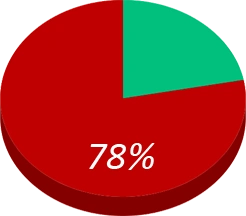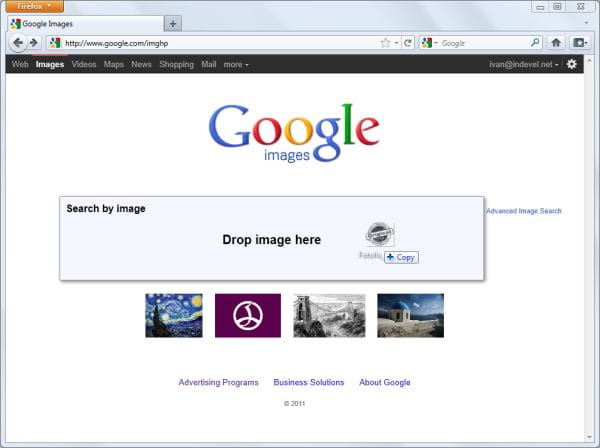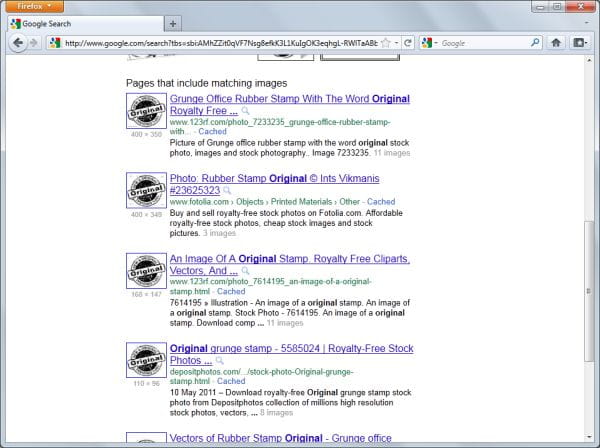78% percents of US photographers say their photos were being used illegally. Most likely your photos were stolen too

Can it be possible to find who is using your images? Now there is an answer. Google started an image reverse search service that uses image identification technology to find exact matches of the photo you ask it to search for. It’s as easy as dragging and dropping your photo into the search box.

Google will upload your photo and search through its database to find if there are any matches. What’s great, it searches for scaled and rotated photos also. For example, I’ve dropped a scaled copy of an image and now it shows me all pages from all over the Internet containing this picture as well.

There are some stock photo websites and about 100 other webpages that uses this photo. It even shows our blog post we used this photo for.
Okay, my photo is stolen. What’s next?
- The first option you have is to do nothing. For example, if the copyright infringer is in a foreign country where copyright law is weak or doesn’t exist, you may decide that it’s not worth your effort to fight the infringement. You may also want to create a watermark for your photos. Here is how to do it - How to watermark photos.
- If you think the website you found your photo on will help you to promote your work, you may ask for a credit line next to your photo. Write the website owner an official letter giving her the right to use the image and include a condition that she must add a copyright notice to the photo and a link to your website.
- If you decided to fight the infringement, you may try to shut down the entire page using a little trick.
All websites require a web server to work. Web servers are operated by web-hosting companies which lease web servers and don’t own websites running on them.
According to US copyright law, web-hosting companies share responsibility for the copyright violation with the website owner. To save themselves from a penalty they should remove the web page immediately after receiving a take-down notice from you or they will be fully responsible for your copyright violation.
Most web hosting companies will suspend the website easily since copyright violation is against their customer agreements as well as againts the copyright law.
You can find examples of take-down notices here, here and here
That’s fine but how can I find out who operates the web server hosting my photo?
Go to the ip-lookup.net website. It’s a free and simple tool that will show you a physical website address (IP-address) and who owns it. I’ve recorded a quick video showing how to use it.
- Also you may request payment for an illegally used photo.
Photographers sometimes send an invoice for three times their normal fee in an attempt to resolve the infringement issue. However, I definately recommend to hire a lawyer to send a demand letter for you. It will cost you some cash, but usually it’s a flat fee or percentage of recovery. Also, it gives you two huge benefits.
When an attorney gets involved, the matter is escalated and tensions rise. While the website owner may be more defensive, the weight of your requests is dramatically increased if it comes from an attorney and the infringer generally takes the matter more seriously.
The second benefit, the website owner may attempt to fill a lawsuit against you saying the use is authorized. This may involve you in a legal action for which you may need person who can deal with it professionally.
Ireland Photographer Jeremy Nicholl has a list of recommended copyright lawyers in US. You may use it to find a good lawyer near you.
How to prevent unauthorized use of your photos?
- Register your photos in the Copyright Office. However only 5% of US-based photographers register their images; virtually no foreign photographers do so. They usually give me two reasons: the registration process is too complex, and that the cost is too high. Neither of these is true. Since the US Copyright Office began accepting online registrations the process has become both simpler and cheaper. And the registration process has guide notes at each stage. Also attorney Carolyn E. Wright wrote detailed guide to copyright registrations.
Registration cost is $105 per a group of photos. I mean, you can register several pictures together and pay only once for it. And there is no limitation on number of images you can register.
- Keep photo by-products on file. If you don’t register your work, you may need an copyright evidence, in other words a proof that it is you who take the photo. This includes RAW files, film and other uncropped originals.
- Clearly mark your photos. Visible watermarking is a very “hot” topic with many pros and cons involved: some people even hate them while others use watermarks to promote their work. So, you should try to publish both watermarked and unwatermarked photos to see which ones will work for you better.
If you didn’t watermark your photos yet, download Visual Watermark – our watermarking tool. It will be very easy for your to watermark a whole disc of photos in minutes using it.
The program is much easier to use than Photoshop and handles multi-sized photos well. I mean, sometimes it is very difficult to watermark a lot of photos because some of them were cropped, some were resized. And we all take both vertical and horizontal photos! Photoshop doesn’t handle them very well, while Visual Watermark does.
We offer a free 30-day trial vesion of Visual Watermark app and 30-day money-back guarantee. So it’s free and safe to try it yourself.
 Visual Watermark
Visual Watermark by
by 